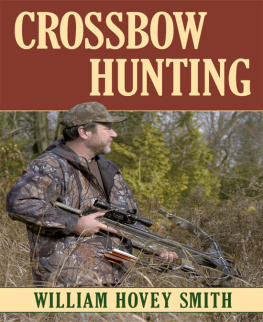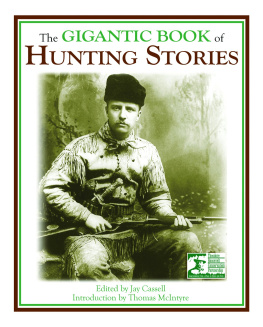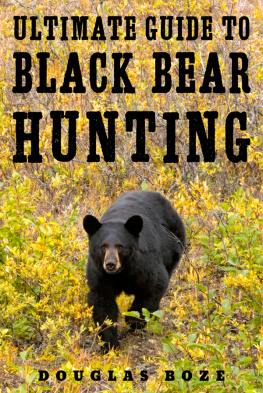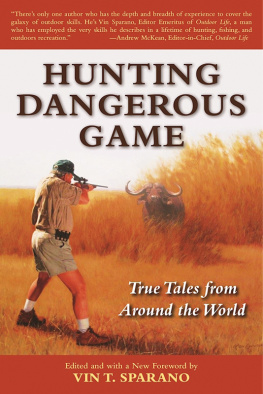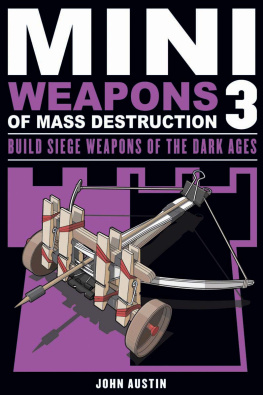William Hovey Smith - Crossbow Hunting
Here you can read online William Hovey Smith - Crossbow Hunting full text of the book (entire story) in english for free. Download pdf and epub, get meaning, cover and reviews about this ebook. year: 2006, publisher: Stackpole Books, genre: Home and family. Description of the work, (preface) as well as reviews are available. Best literature library LitArk.com created for fans of good reading and offers a wide selection of genres:
Romance novel
Science fiction
Adventure
Detective
Science
History
Home and family
Prose
Art
Politics
Computer
Non-fiction
Religion
Business
Children
Humor
Choose a favorite category and find really read worthwhile books. Enjoy immersion in the world of imagination, feel the emotions of the characters or learn something new for yourself, make an fascinating discovery.
- Book:Crossbow Hunting
- Author:
- Publisher:Stackpole Books
- Genre:
- Year:2006
- Rating:5 / 5
- Favourites:Add to favourites
- Your mark:
- 100
- 1
- 2
- 3
- 4
- 5
Crossbow Hunting: summary, description and annotation
We offer to read an annotation, description, summary or preface (depends on what the author of the book "Crossbow Hunting" wrote himself). If you haven't found the necessary information about the book — write in the comments, we will try to find it.
Crossbow Hunting — read online for free the complete book (whole text) full work
Below is the text of the book, divided by pages. System saving the place of the last page read, allows you to conveniently read the book "Crossbow Hunting" online for free, without having to search again every time where you left off. Put a bookmark, and you can go to the page where you finished reading at any time.
Font size:
Interval:
Bookmark:

Discover more Outdoor Sports books, eBooks, and expert advice to plan your next adventure!
From bow hunting to paddling to hiking the Appalachian Trail, Stackpoles Outdoor Sports books give you the tools you need to experience the great outdoors to its fullest.
Visit Stackpole Books Outdoor Sports webpage
History of the
Crossbow
R ather than spending much time exploring the largely conjectural early history of the crossbow, I would like to refer interested readers to Sir Ralph Payne-Gallweys 328-page book The Crossbow: Medieval and Modern Military and Sporting, which was first published in 1903 and has undergone frequent reprintings. An inexpensive paperbacked version has been reissued by Dover Publications. Payne-Gallwey reasoned that the crossbow probably originated in China some two to three thousand years ago and spread westward into the Middle East, Africa, and Europe. Early derivations were used by the Greeks and Romans and more refined versions by the Crusaders. Modernized target and sport crossbows were still being made when he was writing early in the twentieth century.
Several unproven and unprovable theories have emerged to explain how the original vertically held bow became transformed into a horizontal component fixed in a stock and fired by a trigger. A common theory is that the crossbows progenitor was an early type of trap where a bow was held at full draw by a stick to which was tied a string attached to bait. When the bait was pulled away, the restraining stick moved, allowing the bowstring to fire an arrow at the animal. Proponents of this theory claim that this early design could easily evolve into a weapon with a permanent stock to hold the bow and a more sensitive trigger device to discharge the string. The trigger could be as simple as a round stick poking through a flat plank to hold the string. By running the string around a handy root or branch, a downward force would be exerted to pull down the rod, release the string, and fire the arrow.
In this manner, crossbow traps and crossbows could be made without metallic components using wood, cord, and a bit of stone, bone, or sharpened bamboo for a point. Only in bogs, deserts, or arctic environments would traces of such an implement be preserved. Because this technology would have been within the reach of earliest man, the precursor to the crossbow could have been made not two or three thousand years ago, but as long as five to ten thousand years ago, shortly after the bow was developed.

Primitive crossbow trap made with only wood and string. This type of mechanism, which may have been the crossbows ancestor, could have been used shortly after the invention of the bow thousands of years ago.
Another line of thought, although I have not seen it in print, is that the crossbow was first developed from the foot bow, a powerful device that is bent using the legs rather than the relatively weak arms. To use it, the bowman lies on his back, holds the bowstring, and pushes his legs forward to apply pressure to the middle of the bow. When the arrow is fully drawn, it is launched at the target. Foot bows were used for elephant hunting in Asia and Africa, and the Assyrians employed more refined versions as a sort of long-range artillery.
Because mechanical objects are typically substituted for human limbs in the evolution of machines, a wooden handle would have been affixed to an ax to take the place of a hand holding a sharp stone. This would have resulted in less wear on the hand and increasing leverage and force of the blow. Just as shorter and longer handles were affixed to blades to make knives and spears, it is not too much of a technological leap to attach a handle to a foot bow and use it instead of the legs to hold an arrow at full draw. Add a leather or cord stirrup, which would allow a bow (now crossbow) to be drawn while standing, and all of the supporting components of the crossbow are in place. All that remains are the drilling of a hole and the use of a pin to restrain the string, and you have a functional crossbow.
Darwinism has trained modern westerners to look for a single point of origin for an invention and then follow its dispersion and evolution through time and space. To conform to this theory, the crossbow could well have originated, in say, China, and its use could have spread throughout Asia, the Middle East, and Africa, before finally making its way to Europe and the New World. Along the way each country, indeed almost each maker, would have modified the basic crossbow to better use the materials at hand and to make it more effective.
A supporting argument in favor of this straight-line distribution is that although native societies in the Americas had a high degree of technological evolution in some fields, they apparently did not know or use the crossbow, or the wheel for that matter, until these items were introduced by Europeans. Apparently some event in the Asian-African-European experience prompting the invention of the crossbow did not take place in the Americas. Perhaps the absence of huge game animals such as the elephant in the Americas did not prompt the invention of powerful foot-drawn bows.
In reality, crossbow evolution appears to be more along the lines of invention, dispersion, development, discontinuance, rediscovery, evolution, and the coexistence of both primitive and more modern forms. Rather than undergoing a progressive evolutionary process, the crossbow has experienced a lot of stops and starts along the way. Once the concept was known, it did not take long for enterprising minds to reinvent the crossbow and produce it from whatever materials, primitive or modern, that the then-existing technology allowed.

Although of uncertain origin, this crossbow is reputed to be Vietnamese. It employs several leaf springs to power the bow, peg sights, and a simple trigger.
THE HOW AND WHY OF THE MODERN CROSSBOW
If not for the persistence of crossbow target shooting in Europe, the activities of a few pioneering individuals, and the release of a couple of movies, todays most common crossbows would likely be low-powered childrens toys shooting foam arrows. In 1975, the popular Peter Sellerss movie Return of the Pink Panther showed actor Catherine Schell using a skeletal all-metal crossbow with a built-in cocking device to steal the fabulous Pink Panther diamond. This crossbow was built for Pinewoods Studio by Bernard Horton.
Crossbows showed up again in the 1981 James Bond movie For Your Eyes Only when Melina Havelock (Carole Bouquet) used two different crossbows to dispatch the villainous characters who had killed her parents. Just as Clint Eastwoods Dirty Harry boosted the sales of Smith and Wessons .44-Magnum revolver, the appearance of crossbows in several popular movies sparked interest in modernized versions of the ancient crossbow.
In tracing the evolution of the modern hunting crossbow, it seems only appropriate to look at the history of several makers of crossbows and see how they have helped the modern crossbow evolve to what it is today.
Horton Crossbow Company
As a 12-year-old rabbit stalker in the English countryside, Bernard Horton first became interested in crossbows in 1956. He found that he could crawl close enough to his prey to take it with his homemade bow, but when he rose to shoot, the rabbit would spot him and run. The crossbow appealed to him because he could shoot it while prone, and he would not have to reveal himself to his game. When he saw the poor, weak quality of the crossbows and kits that he could afford, Horton thought that he could make a better version.
Font size:
Interval:
Bookmark:
Similar books «Crossbow Hunting»
Look at similar books to Crossbow Hunting. We have selected literature similar in name and meaning in the hope of providing readers with more options to find new, interesting, not yet read works.
Discussion, reviews of the book Crossbow Hunting and just readers' own opinions. Leave your comments, write what you think about the work, its meaning or the main characters. Specify what exactly you liked and what you didn't like, and why you think so.

